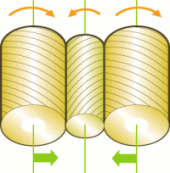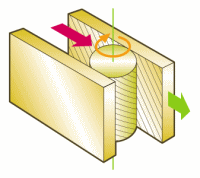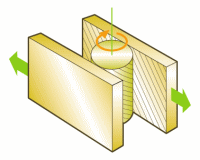A form rolling machine is a device used to shape parts by rolling the work pieces between tools known as dies.
The machines are categorized according to the kind of dies used and the way the dies move. Basically, there are three categories: (1) cylindrical die form rolling machines, (2) flat die form rolling machines, and (3) planetary die form rolling machines.
Tools are cylindrical in shape. Sometimes they are called round dies and sometimes roller dies. Cylindrical die form rolling machines use two, sometimes three, dies of the same shape and size. The dies rotate at the same speed and in the same direction, and they shape the part as the distance between them is narrowed.
There outstanding characteristic is that the distance between the dies can be set freely according to your own requirements, and because of the rotation factor, it's like having an infinitely extendable work surface. They are the most responsive to perfect shaping. Because of that, cylindrical dies are used for a huge variety of parts going far beyond the capability of simple threading platforms. The down side is that, because of that very factor, they are less production efficient than the other two kinds of form rolling machines. NISSEI, as the specialist in form rolling machinery, is dedicated to developing new methods to eliminate the inefficiencies of the past through ever-evolving technological progress.

The tools are shaped like boards, and so they are called flat dies or sometimes board dies or rack dies. The diagram on the right shows the basic principle behind the workings of flat dies. As the diagram illustrates, one die in the pair of dies is stationary. The other moves in a parallel direction and shapes the work piece. The distance between the dies determines the amount of penetration, and when the work piece reaches the end of the dies, it drops out. The distance between the dies cannot be changed during processing. The advantage is high production rate; the disadvantage is limited application. Flat dies are mostly used in mass production of multi-purpose bolts and screws.

A special application that yields superior accuracy is the dual-slide type of flat die form rolling machine. Please refer to the diagram on the left. This machine uses a pair of flat dies that, while parallel, move in opposite directions at the same speed. The work piece does not move during processing. This superior accuracy is particularly applicable to involute spline or involute serration processes. Numerical control-based machines are also now in production.

The tools used are segment-style dies in combination with cylindrical dies. In the forming process, the segment dies are stationary and the cylindrical dies rotate. The work piece is shaped by penetration from the segment dies, and the form depends on the distances between the dies that move in a planetary fashion until the work piece is discharged. The work surface is limited, and the distance between the dies cannot be changed during processing. Applications are limited. Planetary Form Rolling Machines yield the highest production rates of all three types of form rolling machines. The main usage of planetary dies is in mass production venues for multi-purpose threaded parts.
Return Top